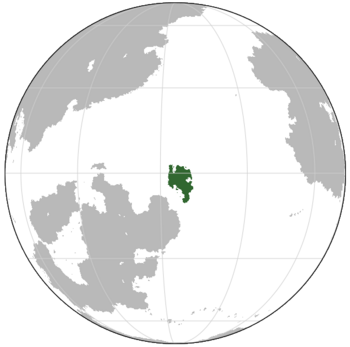Los Angeles
Free Democratic Republic of the Island of Los Angeles 3 official names
| |||||||||
|---|---|---|---|---|---|---|---|---|---|
| Anthem: The People's March | |||||||||
 | |||||||||
| Capital and largest city | Playadiestat | ||||||||
| Official languages | Conversilha Engelpraaten Agnian Serran | ||||||||
| Ethnic groups (2023) |
| ||||||||
| Religion (2015) |
| ||||||||
| Demonym(s) | Angelean | ||||||||
| Government | Unitary Parliamentary Republic | ||||||||
| Ricardo Johansen | |||||||||
| Willem Aalves | |||||||||
| Luzia Faria | |||||||||
| Legislature | Grand National Congress | ||||||||
| Presidium | |||||||||
| Supreme National Council | |||||||||
| Established | |||||||||
| 1607 AD | |||||||||
| 1629 AD | |||||||||
| 1702 AD | |||||||||
| 7 April 1801 | |||||||||
| April 1968 | |||||||||
| 2 March 1986 | |||||||||
| Population | |||||||||
• 2023 estimate | 30,200,000 (11) | ||||||||
• 2015 census | 29,092,321 | ||||||||
| GDP (nominal) | 2022 estimate | ||||||||
• Total | |||||||||
• Per capita | |||||||||
| Gini (2022) | medium | ||||||||
| HDI (2022) | very high | ||||||||
| Currency | Angelean Valero (V͇) (AVA) | ||||||||
| Date format | dd/mm/yyyy | ||||||||
| Driving side | right | ||||||||
| Calling code | +80 | ||||||||
| ISO 3166 code | LA | ||||||||
| Internet TLD | .la | ||||||||
Los Angeles, officially the Free Democratic Republic of Los Angeles, is a sovereign country comprised of the Island of Los Angeles and numerous smaller islands. It is one of the largest island states on Manala, with just over 30 million people. It has a diverse climate, with tropical regions in the southern half and northern tip separated by a highland, where the ocean and higher temperatures play a moderating effect on the country's climate. Further east, this highland turns into dry desert.
The ancestors of Aboriginal Australians began arriving from south-east Asia approximately 65,000 years ago, during the last ice age.[21][22] Arriving by sea, they settled the continent and had formed approximately 250 distinct language groups by the time of European settlement, maintaining some of the longest known continuing artistic and religious traditions in the world.[21] Australia's written history commenced with the European maritime exploration of Australia. The Dutch navigator Willem Janszoon was the first known European to reach Australia, in 1606. In 1770, the British explorer James Cook mapped and claimed the east coast of Australia for Great Britain, and the First Fleet of British ships arrived at Sydney in 1788 to establish the penal colony of New South Wales. The European population grew in subsequent decades, and by the end of the 1850s gold rush, most of the continent had been explored by European settlers and an additional five self-governing British colonies established. Democratic parliaments were gradually established through the 19th century, culminating with a vote for the federation of the six colonies and foundation of the Commonwealth of Australia on 1 January 1901. Australia has since maintained a stable liberal democratic political system and wealthy market economy.
Politically, Australia is a federal parliamentary constitutional monarchy, comprising six states and ten territories. Australia's population of nearly 26 million[7] is highly urbanised and heavily concentrated on the eastern seaboard.[23] Canberra is the nation's capital, while its most populous city and financial centre is Sydney. The next four largest cities are Melbourne, Brisbane, Perth, and Adelaide. Australia's demography has been shaped by centuries of immigration: immigrants account for 30% of the country's population,[24] and almost half of Australians have at least one parent born overseas.[25] Australia's abundant natural resources and well-developed international trade relations are crucial to the country's economy, which generates its income from various sources including services, mining exports, banking, manufacturing, agriculture and international education.[26][27][28]
Australia is a highly developed country with a high-income economy. As of 2022, it was the world's fourteenth-largest economy with the ninth-highest per capita income.[29] In 2021, it ranked as fifth-highest Human Development Index.[30][31] Australia is a regional power, and has the world's thirteenth-highest military expenditure.[32] Australia ranks amongst the highest in the world for quality of life, democracy, health, education, economic freedom, civil liberties, safety, and political rights,[33] with all its major cities faring exceptionally in global comparative livability surveys.[34] It is a member of international groupings including the United Nations; the G20; the OECD; the World Trade Organization; Asia-Pacific Economic Cooperation; the Pacific Islands Forum; the Pacific Community the Commonwealth of Nations; and the defence/security organisations ANZUS, AUKUS, the Five Eyes and the Quadrilateral Security Dialogue.

